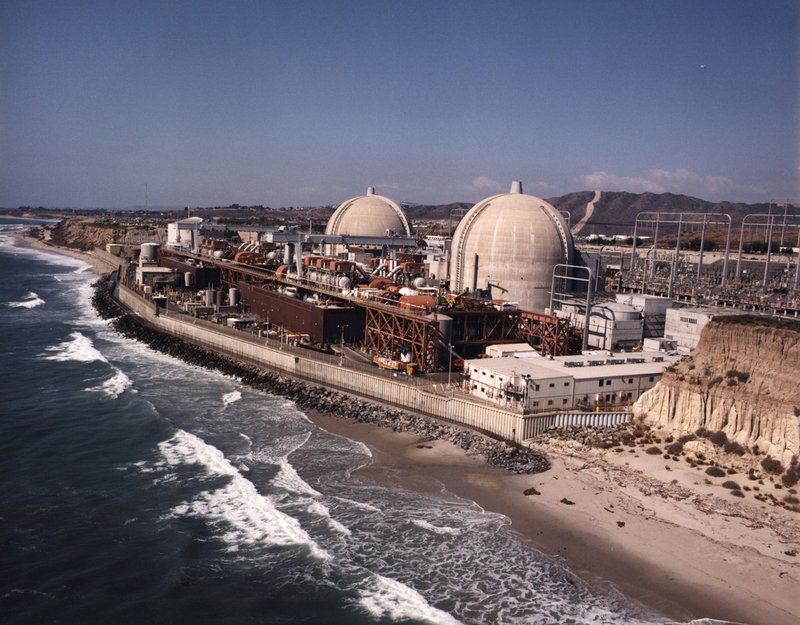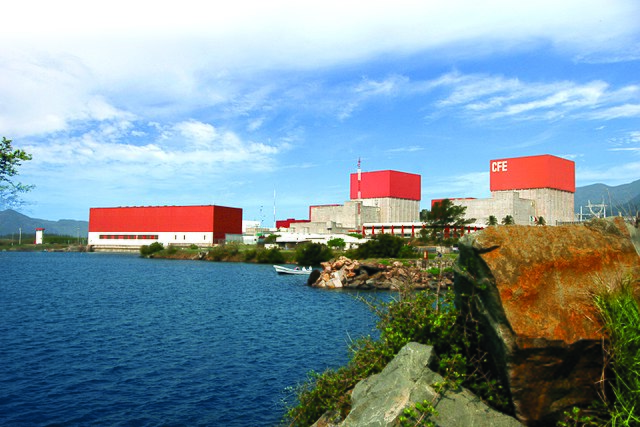Retention basins at the Liquid Effluent Retention Facility on the Hanford Site, as seen in September 2021, at top, and recently with the nearly completed Basin 41 on the far left. (Photo: DOE)
Work is nearing completion on a fourth basin needed to ensure adequate storage for wastewater during tank waste treatment on the Department of Energy’s Hanford Site, in Washington state.
According to the DOE, its operations contractor Washington River Protection Solutions (WRPS) has made significant progress on Basin 41 at the Liquid Effluent Retention Facility (LERF) since concrete was first poured for the perimeter one year ago.
Video: Watch this time-lapse video of the LERF Basin 41 construction.
DOE contractor Savannah River Mission Completion strengthened its ties with Aiken Technical College as the school graduated the first class of Nuclear Fundamentals trainees this summer. (Photo: DOE)
The first 36 students graduated this summer from Savannah River Mission Completion’s (SRMC) Nuclear Fundamentals Certificate program. SRMC is the Department of Energy’s liquid waste contractor at the Savannah River Site (SRS) in South Carolina.
The program, which is a partnership between Aiken Technical College (ATC) and SRMC, is in its inaugural year.
The San Onofre nuclear power plant.
The San Onofre Nuclear Generating Station (SONGS) recently shared a few videos on its YouTube channel, showing recent progress Southern California Edison has made in dismantling the plant’s turbine building. Decommissioning of the nuclear power plant, which permanently ceased operations in 2013, is being conducted by SONGS Decommissioning Solutions, a joint venture of EnergySolutions and AECOM.
While many Californians are hopeful the state’s last nuclear power reactor can be saved, PG&E is actively preparing for decommissioning.
The Diablo Canyon nuclear power plant in San Luis Obispo County, Calif.
(Photo: Wikimedia Commons)
The reports of the death of the Diablo Canyon nuclear power plant may be greatly exaggerated. While Pacific Gas and Electric (PG&E) announced as early as 2016 that it would be closing California’s last operating nuclear power plant at the end of its current operating license, there has been growing political pressure to keep the plant, and its 2,200 MWe of carbon-free energy, running.
The Philippine Research Reactor-1 building at the University of the Philippines. (Photo: PNRI)
The research reactor known as SATER (Subcritical Assembly for Training, Education, and Research), housed in at the Philippine Research Reactor-1 building at the University of the Philippines in Quezon City, has become operational. As recently reported by the International Atomic Energy Agency, the core of SATER was loaded with 44 fuel rods, bringing the Philippines its first operational nuclear reactor in 34 years. Through this event, the country has moved a big step closer to meeting the government’s goal of adding nuclear power to its energy resources. The reactor is expected to become fully operational by 2023.
The twin-unit Hatch plant (Image: Southern Nuclear)
Southern Nuclear, operator of the two-unit Hatch nuclear plant, announced yesterday that it will seek subsequent license renewals (SLR) for both reactors.
The Diablo Canyon nuclear power plant.
Bowing at last to the unflagging efforts of nuclear advocates over the past few years—as well as to more recent pressure from a former nuclear opponent, Gov. Gavin Newsom—the California legislature late last night approved S.B. 846, a measure that provides the option of extending operations at the Diablo Canyon nuclear power plant for five years beyond its scheduled 2025 closure date.
Pacific Gas and Electric, Diablo Canyon’s owner and operator, had agreed in June 2016 to an early shuttering of the facility, following discussions with organized labor and environmental organizations. PG&E’s application to close the plant was approved by the California Public Utilities Commission in January 2018.
The bill passed easily through both legislative chambers: 67–3 in the General Assembly and 31–1 in the Senate.
Tiara Carrasquillo Pérez (far left) and Matt Hageman (far right) are pictured with five other WISE interns and FMR Gil Brown (center front).
For the first time since 2019, student interns were welcomed to Washington, D.C., for the summer to participate in the Washington Internships for Students of Engineering (WISE) program. Among them were two students sponsored by ANS—Tiara Carrasquillo Pérez and Matt Hageman.
The Laguna Verde nuclear power plant. (Photo: HFStudio)
Unit 2 at Mexico’s Laguna Verde nuclear plant has been given the go-ahead to operate into the 2050s, plant owner and operator Comisión Federal de Electricidad (CFE) announced last week.
Mexico’s secretary of energy, Norma Rocío Nahle García, approved a 30-year extension to the unit’s operating license on August 25, following a review by the country’s National Commission for Nuclear Safety and Safeguards. The reactor, one of two at the plant, is now authorized to run until April 10, 2055.

















 The National Association of Regulatory Utility Commissioners (NARUC) has published
The National Association of Regulatory Utility Commissioners (NARUC) has published  As energy security and environmental concerns prompt some countries to increase their reliance on nuclear energy or become first-time adopters of the technology, the U.S. government must decide whether it will offer financing for reactor exports—a move that poses financial risks but could create jobs, address global climate and energy security challenges, and limit Chinese and Russian influence. A new
As energy security and environmental concerns prompt some countries to increase their reliance on nuclear energy or become first-time adopters of the technology, the U.S. government must decide whether it will offer financing for reactor exports—a move that poses financial risks but could create jobs, address global climate and energy security challenges, and limit Chinese and Russian influence. A new